With aluminium continuing as the lightweight material of choice, Chemetall explains why a smarter approach to pretreatment of high-share aluminium content vehicle bodies is required

The use of lightweight materials in the automotive industry is expected to significantly grow in volume. Whereas car bodies, chassis and wheels used to be exclusively made from steel, vehicle producers are showing a greater interest in using lightweight materials, such as aluminium. Their goal is to reduce vehicle weight, a feature that has a direct impact on driving dynamics, fuel consumption and, by extension, lower CO2 emissions.
During the past ten years, the share of aluminium in car bodies has more than doubled with certain car manufacturers and models. Replacing steel with aluminium can achieve weight savings of up to 250kgs.
The use of aluminium alloys with magnesium, silicon and other metals, can further strengthen extruded sections in terms of vehicle body stability. Another beneficial aspect of aluminium is its ease of formability and the new approaches in both interior and exterior design it enables.
Through the changes in the material mix, challenges but also significant opportunities are emerging. One example is the pretreatment of multi-metal car bodies with a high share of aluminium content.
Innovative and sustainable technologies
In the pretreatment process, the introduction of a variety of metals, requires robust technologies since different substrates exhibit various reactivity profiles. Chemetall, the global business unit of BASF’s Coatings Division, has developed innovative and sustainable technologies to meet the automotive industry’s demands for a higher aluminium content in car bodies.
With GardoFlex, Chemetall offers a highly flexible pretreatment zinc-phosphate technology that is suited for multi-metal pretreatment with a maximum throughput of aluminium substrates. Dr. Sven K. Weber, Global Segment Manager Automotive OEM at Chemetall, explains: “One of the strengths of the GardoFlex technology is the deposition of a uniform, thin zinc-phosphate coating on the aluminium, regardless of the total amount in a car body.
“Minor surface irregularities such as scrub marks, scratches or impressions from the vacuum cups of the robots resulting from car body construction or pressing, are smoothed out by a thin phosphate coating. GardoFlex thin phosphate coating enables the deposition of a homogeneous surface.”
In conventional zinc-phosphating solutions, the first reaction step is acidic pickling of all the substrates. In this process, metal ions accumulate in the pretreatment bath. Since iron ions create a filtrable iron phosphate sludge, the free aluminium ions need to be complexed. This is done with the aid of free fluoride which – in the presence of sodium – forms a substance called cryolite.
Cryolite is slightly soluble and needs to be removed from the phosphating bath by filtration. If the aluminium is not complexed, the aluminium ions can act as a bath poison and may interfere in the formation of a zinc-phosphate coating. “Even when treating higher amounts of aluminium, the GardoFlex process allows lower etching rates on this substrate which results in a significantly reduced amount of cryolite and phosphate sludges,” states Dr. Weber.
Continuous phosphate coating
Chemetall has developed an innovative solution to prevent such poisoning and to improve the process. A continuous phosphate coating is beneficial because the subsequent cathodic electropaint can be deposited more evenly. As the amount of aluminium in car bodies rises, achieving a uniform coating formation is challenging. With GardoFlex, sealed phosphate coatings on all metal substrates in a multi-metal car body can be achieved.
“Beyond offering excellent corrosion protection in combination with the paint coat, these coatings ensure superior metal surface coverage. The phosphate layer evens out many defects. This provides a significant advantage, and makes the subsequent painting process less susceptible to reworking”, says Robert Vengust, Account Manager Automotive OEM at Chemetall.
“When treating higher amounts of aluminium, GardoFlex allows lower etching rates on the substrate which results in a significantly reduced amount of cryolite and phosphate sludges”
In the case of a multimetal car body with more than 80% aluminium, sodium and fluoride are added to better control the bath reactions. Continuous addition of these two substances leads to a reaction with the aluminium ions to create cryolite, which then settles as sludge and can be removed by means of filtration. The challenge is to add the two substances at the correct stoichiometric ratio.
If sodium and fluoride are added too quickly, it accelerates the formation of cryolite sludge that settles on the car body. It then creates a rough surface that would directly affect the subsequent step – ie, electrophoretic painting.

If sodium and fluoride are added to the bath in the wrong ratio or in insufficient quantities, the aluminium ions will accumulate in the bath. The consequence is another example of bath poisoning, leading again to pretreatment deficiencies and an uneven coated surface finish. To mitigate risks at the customers’ production, Chemetall simulates and tests the process at its own laboratories prior to customer implementation. As a result, car bodies with an average share of aluminium of more than 80% can now be zinc-phosphated and optimally protected against corrosion.
Low operating temperatures
Beyond the uniform surface finish and process management, an additional benefit of GardoFlex is its low operating temperature resulting in energy cost savings. Also by optimising all process elements, a longer bath life can be achieved. This results in lower water consumption and smaller effluent volumes. The reduced amount of modified phosphate sludge can be removed more easily. This means that clogged pipes and high sludge volumes are a thing of the past.
In 2019, more than 10 million vehicles have been treated with the GardoFlex technology. “Together with our customers, we continue to develop innovative technologies that offer optimal corrosion protection - regardless of the percentage of aluminium in vehicle bodies,” Dr. Weber summarises. GardoFlex presents a valuable economical alternative to pretreatments of the past while addressing future industry trends.








































No comments yet